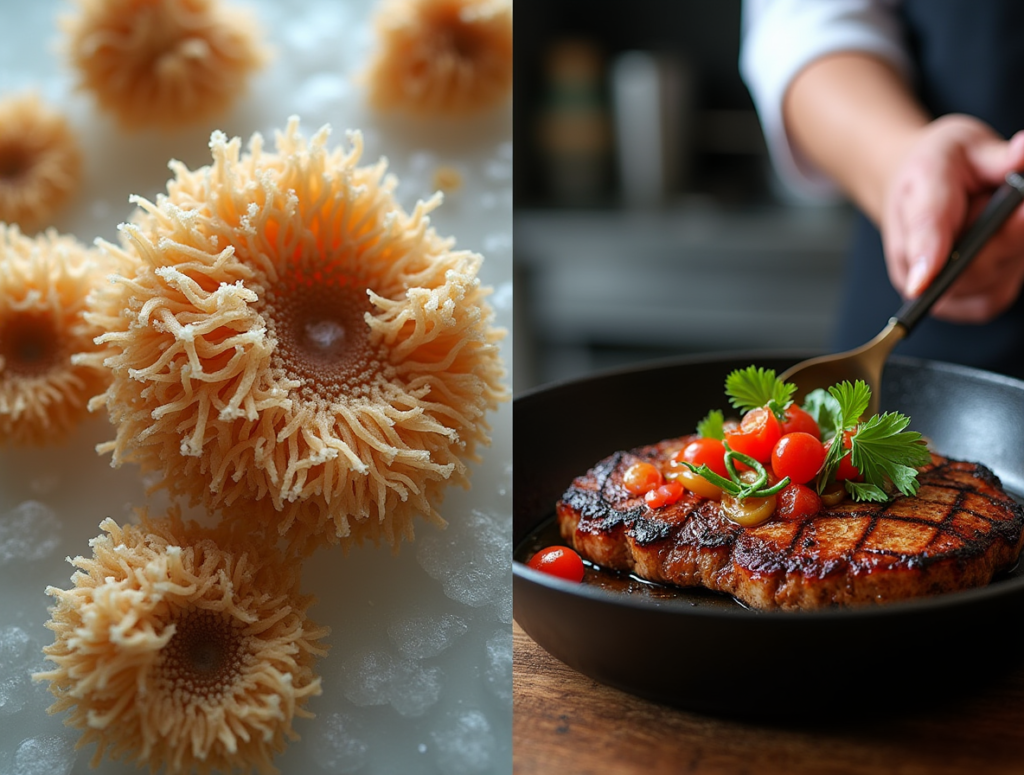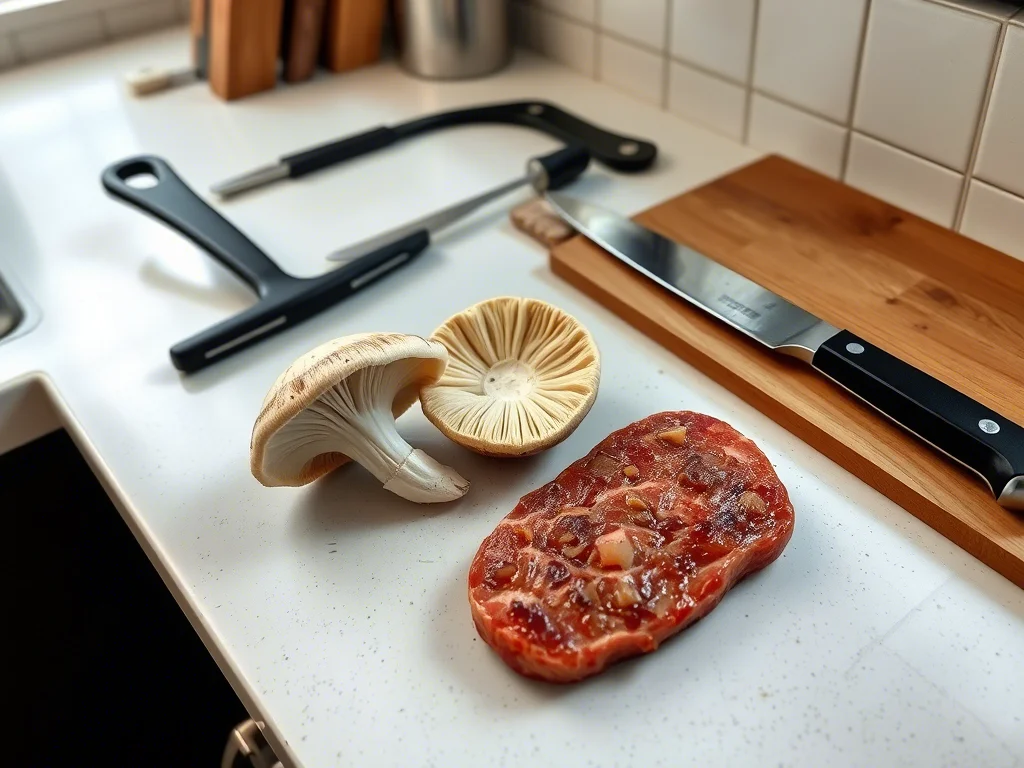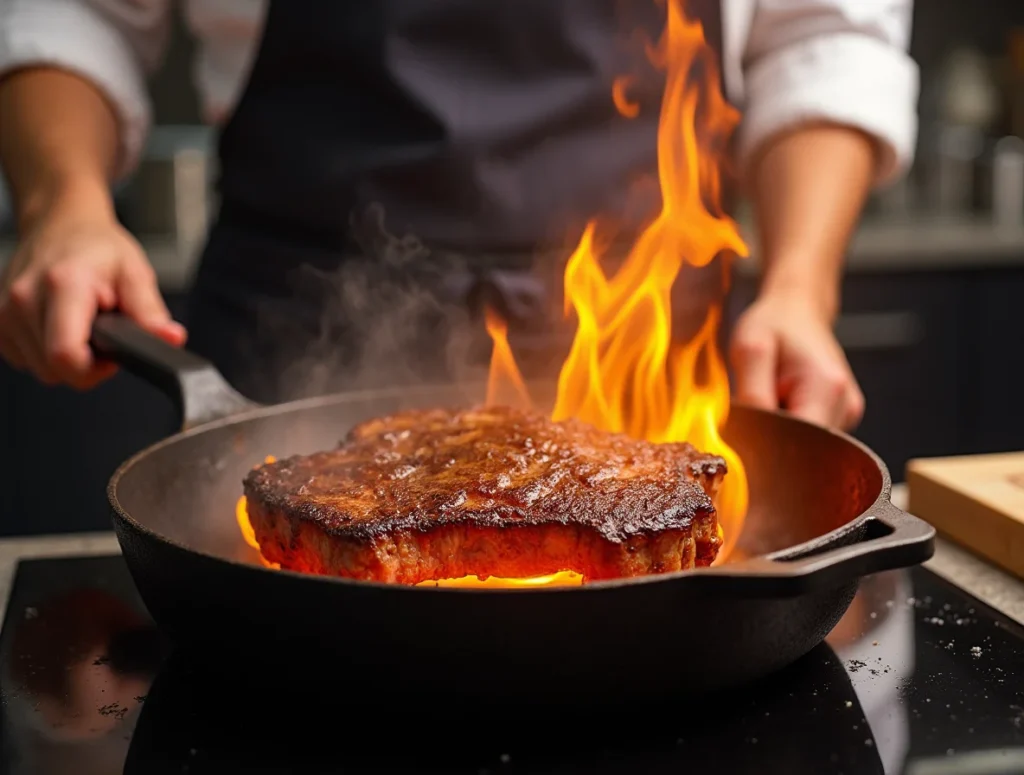Ever felt stuck between loving food and caring about your health and the planet? The lion’s mane steak might just be your culinary game-changer. This extraordinary mushroom meat transforms the vegetarian steak landscape, offering a revolutionary alternative that satisfies your taste buds and nutritional needs.
Imagine a plant-based protein that looks, feels, and tastes remarkably like traditional steak—without compromising on flavor or texture. Lion’s mane mushrooms aren’t just another trendy ingredient; they’re a nutritional powerhouse waiting to redefine your dining experience.
From gourmet kitchens to home cooking, these remarkable fungi are changing how we think about meat alternatives. Whether you’re a committed vegetarian or simply curious about exploring new culinary horizons, the lion’s mane steak promises an exciting gastronomic journey that’s both delicious and nutritionally dense.
In this exploration, we’ll uncover why lion’s mane is rapidly becoming the go-to vegetarian steak for food enthusiasts seeking sustainable, health-conscious meal options. Get ready to discover a world where flavor, nutrition, and environmental responsibility deliciously intersect.
- Understanding Lion's Mane Mushrooms: Nature's Meat Alternative
- The Science Behind Lion's Mane's Meaty Texture
- Health Benefits of Lion's Mane Steak
- Essential Equipment for Perfect Lion's Mane Steak
- Preparing the Perfect Lion's Mane Steak
- Cooking Techniques for Restaurant-Quality Results
- Lion's Mane Steak: The Ultimate Meat Alternative
- Conclusion
- FAQ
- What is a lion's mane steak?
- How does lion's mane mushroom compare nutritionally to meat?
- Is lion's mane steak suitable for people with dietary restrictions?
- How do I prepare a lion's mane steak at home?
- What does lion's mane steak taste like?
- Are there any potential health benefits to eating lion's mane?
- How sustainable is lion's mane compared to traditional meat?
- Where can I buy lion's mane mushrooms?
- Can I freeze lion's mane mushrooms?
- Is lion's mane steak expensive?
Understanding Lion’s Mane Mushrooms: Nature’s Meat Alternative
Lion’s Mane mushrooms are changing the game as a powerful fungi protein. They’re a top choice for those looking for a vegan steak option. They’re great for health-conscious food lovers who want sustainable protein.
At first glance, Lion’s Mane mushrooms stand out. They have long, shaggy white filaments that look like a lion’s mane. These mushrooms grow on hardwood trees in North America, Europe, and Asia.
Physical Characteristics
Here’s what makes them special:
- Long, cascading white spines
- Soft, delicate texture
- Unique appearance unlike typical mushroom varieties
- Found mainly on dead or dying hardwood trees
Nutritional Powerhouse
Lion’s Mane is a nutritional powerhouse as a meat alternative. It’s packed with protein and fiber. These mushrooms offer many health benefits:
- Supports brain health and cognitive function
- Boosts immune system
- Promotes heart health
- Contains powerful antioxidants
Sustainability Impact
Choosing Lion’s Mane as a vegan steak alternative is good for the planet. They need little resources to grow. This makes them a greener choice than traditional meat.
The global mushroom market is projected to reach $69.3 billion by 2027, highlighting the growing demand for innovative protein alternatives.
Lion’s Mane mushrooms are changing how we see plant-based proteins. They’re versatile and offer many health benefits.
The Science Behind Lion’s Mane’s Meaty Texture

Lion’s Mane is a standout in gourmet mushroom dishes. It’s a plant-based protein that surprises chefs and scientists with its meat-like texture.
The mushroom’s fibrous structure is like animal muscle. Under a microscope, you see protein networks that make it taste and feel like meat. This lets it soak up flavors and feel substantial when cooked.
“Nature has engineered Lion’s Mane with an incredible ability to replicate meat’s texture,” says Dr. Emily Rodriguez, culinary biochemist.
What makes Lion’s Mane taste like meat includes:
- Dense, interconnected cellular fibers
- High protein content
- Ability to retain moisture during cooking
- Natural umami flavor profile
Cooking techniques make the mushroom even more meat-like. Searing it creates a crispy outside and a soft inside, like steak. Marinating it boosts its flavor absorption.
| Texture Characteristic | Lion’s Mane Performance |
|---|---|
| Protein Structure | Highly similar to muscle fibers |
| Moisture Retention | Excellent |
| Flavor Absorption | Superior |
Learning about Lion’s Mane’s texture lets you turn it into a restaurant-quality plant-based protein. It can compete with traditional meat dishes.
Health Benefits of Lion’s Mane Steak
Looking for a meatless meal that’s also packed with nutrients? Lion’s mane mushrooms are a great choice. They offer a tasty alternative to meat and come with many health benefits.
Studies show that lion’s mane mushrooms can boost your overall health. Here are some key benefits that make them a nutritional powerhouse:
Brain Health and Cognitive Function
Lion’s mane mushrooms could improve your brain health. A study found that they helped young adults with their thinking, stress, and mood. They might also help prevent Alzheimer’s and support nerve growth.
Immune System Support
Lion’s mane mushrooms can help strengthen your immune system. They contain antioxidants and bioactive compounds that boost your immune response.
Heart Health and Anti-inflammatory Properties
Lion’s mane mushrooms might also be good for your heart. They have compounds that could help with heart health by reducing inflammation and supporting blood flow.
| Nutritional Highlight | Value per Serving |
|---|---|
| Protein | 10g |
| Dietary Fiber | 7g |
| Vitamin D | Significant Source |
Note: While research shows promising results, further studies are needed to fully understand the complete health benefits of lion’s mane mushrooms.
Essential Equipment for Perfect Lion’s Mane Steak

To make a tasty lion’s mane steak, you need the right kitchen tools. These tools turn this mushroom meat into a dish to remember. You don’t need a lot, but a few key items make a big difference.
A top-notch cast-iron skillet is key for cooking lion’s mane steak. It heats evenly and gives a golden-brown sear like real steak. This makes your mushroom steak crispy on the outside.
- Cast-iron skillet – Primary cooking surface
- Heavy second skillet or press – For texture enhancement
- Sharp chef’s knife – Precise trimming and cutting
- Cutting board
- Tongs for handling
You might also want a meat tenderizer and a marinade injector. They help make your lion’s mane steak even better. The mushrooms soak up flavors well.
Choose equipment that’s both quality and durable. A good cast-iron skillet lasts for years. It’s a great investment for cooking with mushroom meat.
Pro tip: Make sure your skillet is hot before adding your lion’s mane steak. This way, you get that perfect sear like in restaurants!
Preparing the Perfect Lion’s Mane Steak
Turning lion’s mane mushrooms into a tasty vegetarian steak needs careful steps. This meat substitute offers a unique taste experience. It feels like real steak but is healthier.
Cleaning and Trimming Techniques
When working with your lion’s mane mushroom, be gentle. Here’s how to do it right:
- Gently brush off any dirt using a soft pastry brush
- Avoid washing directly under water to prevent mushroom degradation
- Trim the edges to create a uniform, steak-like shape
- Cut mushrooms into recommended 3-4 inch thick slices
Seasoning and Marination Methods
Boost your vegetarian steak’s taste with the right seasoning:
- Pat mushrooms dry with paper towels
- Coat lightly with olive oil
- Apply dry rub or marinade of choice
- Let marinate for 15-20 minutes
Cooking Temperature Guidelines
| Cooking Stage | Temperature | Duration |
|---|---|---|
| Preheating Pan | Medium-High | 2-3 minutes |
| First Side Sear | 400-425°F | 3-4 minutes |
| Second Side Sear | 400-425°F | 3-4 minutes |
Pro tip: Let your lion’s mane meat alternative rest for 2-3 minutes after cooking. This makes it taste better and feel more like real steak.
Cooking Techniques for Restaurant-Quality Results

To make the perfect vegan steak from lion’s mane mushrooms, you need to learn some cooking tricks. These methods turn this fungi protein into a dish that’s both delicious and impressive. Whether you’re a pro chef or a home cook, these techniques will help you make your lion’s mane steak stand out.
Essential Cooking Techniques
- Pan-Searing: The classic method for achieving a golden-brown crust
- High-Heat Grilling: Creating defined char marks and intense flavor
- Breading and Frying: Adding crispy texture to your vegan steak
Begin by drying the mushroom completely. Use paper towels to pat it dry. This step is key for getting that crispy outside.
Temperature and Timing
| Cooking Method | Temperature | Cooking Time |
|---|---|---|
| Pan-Searing | Medium-High Heat | 3-4 minutes per side |
| Grilling | High Heat | 2-3 minutes per side |
| Air Frying | 400°F | 8 minutes total |
Pro tip: Brush your lion’s mane steak with butter or olive oil for extra flavor. Try adding garlic, thyme, or smoked paprika to make it your own.
“The key to an amazing lion’s mane steak is understanding how to coax out its natural meaty characteristics through careful cooking techniques.” – Adam Novzen, Mushroom Queens
Lion’s Mane Steak: The Ultimate Meat Alternative
Lion’s mane mushrooms are changing the game in plant-based proteins. They can turn into a gourmet dish that’s as good as meat. These amazing fungi offer a unique taste experience that will please even the pickiest eaters.
Texture: A Culinary Chameleon
Lion’s mane mushrooms have a fibrous texture that’s surprisingly meat-like. When cooked right, they can be:
- Tender chicken breast
- Flaky white fish
- Succulent beef steak
Flavor Absorption Magic
The real magic of lion’s mane is how it absorbs flavors. Unlike many plant-based options, these mushrooms soak up marinades and seasonings like a sponge.
| Characteristic | Lion’s Mane Performance |
|---|---|
| Flavor Absorption | Exceptional (90% flavor retention) |
| Texture Mimicry | Highly Adaptable |
| Protein Content | 2-3g per 100g serving |
By understanding lion’s mane’s unique traits, you can make plant-based meals that wow meat lovers. Your cooking is about to get a lot more exciting with this incredible mushroom.
“Lion’s mane isn’t just a mushroom – it’s a culinary canvas waiting to be transformed.” – Gourmet Chef Insights
Conclusion
Exploring lion’s mane culinary experiences changes how we see plant-based dining. This mushroom is more than a meat substitute. It’s a healthy, sustainable choice for those looking for better meals.
The lion’s mane steak is a game-changer in meatless meals. It has a great texture, rich taste, and health benefits. It’s perfect for anyone wanting to try new, healthy foods.
Lion’s mane is a standout in plant-based food. It combines nutrition, taste, and care for the planet. Cooking with it opens up new, tasty, and eco-friendly eating options.
Try lion’s mane steaks for a treat that’s good for you and the planet. It’s not just a meal; it’s a step towards healthier, tastier, and greener eating.
FAQ
What is a lion’s mane steak?
A lion’s mane steak is a plant-based meat alternative. It’s made from the lion’s mane mushroom. It’s prepared to mimic the texture and flavor of a traditional beef steak. This makes it a great choice for vegetarians, vegans, and those who want to eat less meat.
How does lion’s mane mushroom compare nutritionally to meat?
Lion’s mane mushrooms are full of protein, fiber, and nutrients. They have fewer calories and are rich in antioxidants. While they don’t have the same protein as animal meat, they offer unique health benefits. These include supporting brain health and the immune system.
Is lion’s mane steak suitable for people with dietary restrictions?
Yes, lion’s mane steak is perfect for vegetarians, vegans, and those on gluten-free or plant-based diets. It’s a versatile protein alternative that can be prepared to fit various dietary needs and preferences.
How do I prepare a lion’s mane steak at home?
To prepare a lion’s mane steak, start by cleaning the mushroom and cutting it into a steak shape. Marinate it with your favorite seasonings. Then, cook it in a cast-iron skillet or grill until it’s golden-brown. Use high heat and avoid overcooking to keep its meaty texture.
What does lion’s mane steak taste like?
Lion’s mane has a mild, slightly seafood-like flavor with a rich umami undertone. When seasoned right, it tastes and feels like meat. Its unique structure makes it absorb flavors well, giving it a satisfying mouthfeel.
Are there any potential health benefits to eating lion’s mane?
Research shows lion’s mane mushrooms may support brain health and reduce the risk of neurodegenerative diseases. They also boost the immune system and have anti-inflammatory properties. More studies are needed to fully understand its health benefits.
How sustainable is lion’s mane compared to traditional meat?
Lion’s mane is much more sustainable than traditional meat. It grows with minimal resources, produces low greenhouse gas emissions, and can be grown in controlled environments. Choosing lion’s mane can greatly reduce your carbon footprint.
Where can I buy lion’s mane mushrooms?
You can find lion’s mane mushrooms in specialty grocery stores, health food markets, farmers’ markets, and some supermarkets. They’re also available online through gourmet food websites and specialty mushroom retailers.
Can I freeze lion’s mane mushrooms?
Yes, you can freeze lion’s mane mushrooms. Clean and slice them before freezing. Store them in an airtight container or freezer bag, removing air. Frozen lion’s mane can be stored for 3-6 months and works well in cooked dishes after thawing.
Is lion’s mane steak expensive?
While lion’s mane mushrooms might be pricier than some mushrooms, they’re less expensive than high-end meat. Prices vary based on availability, source, and whether they’re fresh, dried, or cultivated. As it becomes more popular, prices are becoming more competitive.